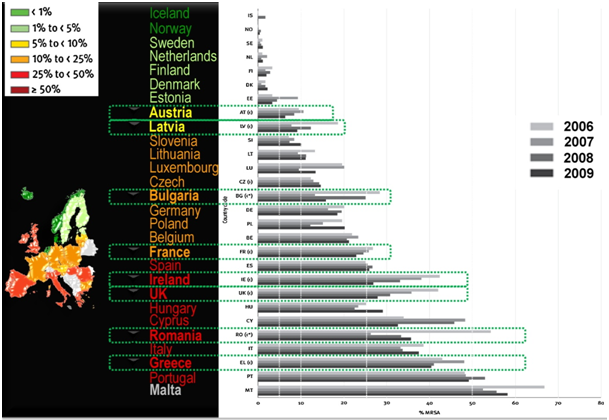In the pre-antibiotic era, S. aureus bacteraemia was usually fatal. In a review of cases in the early 1940s, mortality amongst 122 consecutive patients was 82%, and was 98% in those aged >50 years. In the modern era, it is estimated that 25–35% of healthy human individuals carry S. aureus on the skin or mucous membranes. This means that up to two billion individuals may currently carry S. aureus worldwide, and conservative estimates based on Dutch and US prevalence data predict that between 2–53 million people carry MRSA.
Staphylococcus aureus is the number one cause of hospital-associated infections, and a high proportion of these are caused by MRSA. The mortality rate associated with invasive MRSA infections is estimated at ca. 20% but varies considerably between studies in different settings. In a recent large European prospective cohort study, mortality and length of stay attributable to S. aureus bloodstream infections were evaluated. Results demonstrated the clinical importance of S. aureus invasive infections and unequivocally underlined the additional burden imposed by resistance for 30-day mortality.
The evolution of MRSA has paralleled that of penicillin-resistant S. aureus from the 1940s. MRSA is now pandemic, with dissemination of HA-MRSA clones from the 1960s, CA-MRSA clones from the 1990s, and LA-MRSA clones from the 2000s. MRSA is highly prevalent in hospitals worldwide (Fig. 1). Although epidemiological data from separate studies are often not comparable owing to differences in study design and populations sampled, the highest rates (>50%) are reported in North and South America, Asia and Malta. Intermediate rates (25–50%) are reported in China, Australia, Africa and some European countries [e.g. Portugal (49%), Greece (40%), Italy (37%) and Romania (34%)]. Other European countries have generally low prevalence rates (e.g. The Netherlands and Scandinavia)
The prevalence of HA-MRSA has declined in recent years in some European countries, e.g. Austria, France, Ireland, the UK and Greece. In other European countries the prevalence has remained fairly stable (Fig. 2). However, very high rates of MRSA (MRSA as proportion of HA S. aureus infections) are reported in East Asia, especially in Sri Lanka (86.5%), South Korea (77.6%), Vietnam (74.1%), Taiwan (65.0%), Thailand (57.0%) and Hong Kong (56.8%). In contrast, the values are much lower in India (22.6%) and The Philippines (38.1%).
Related posts

